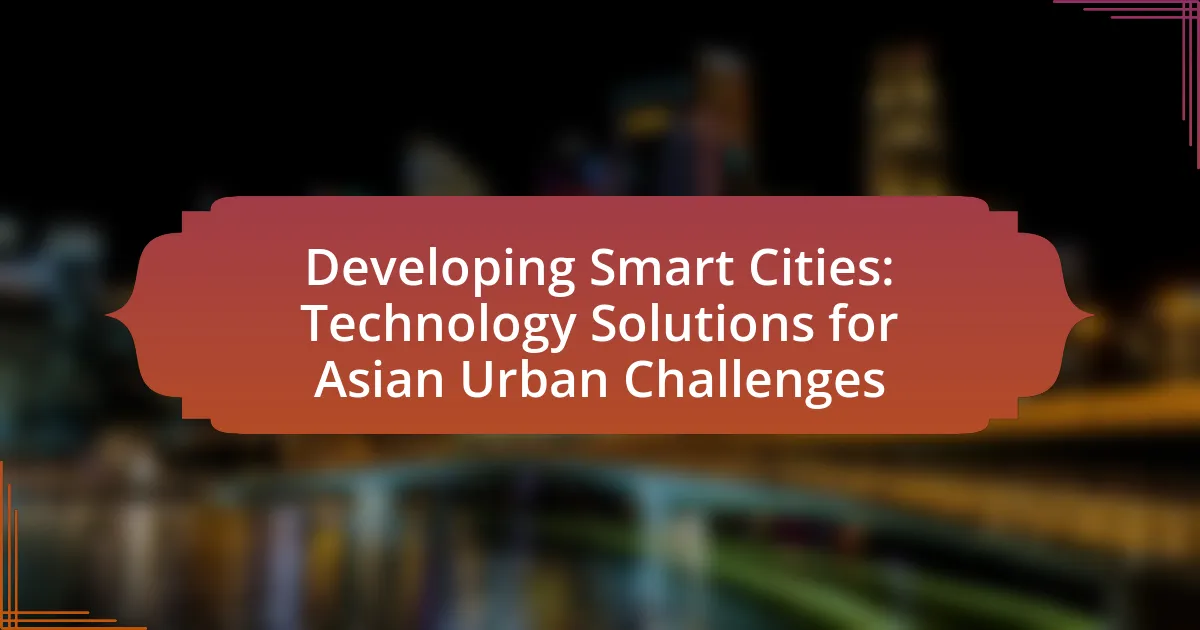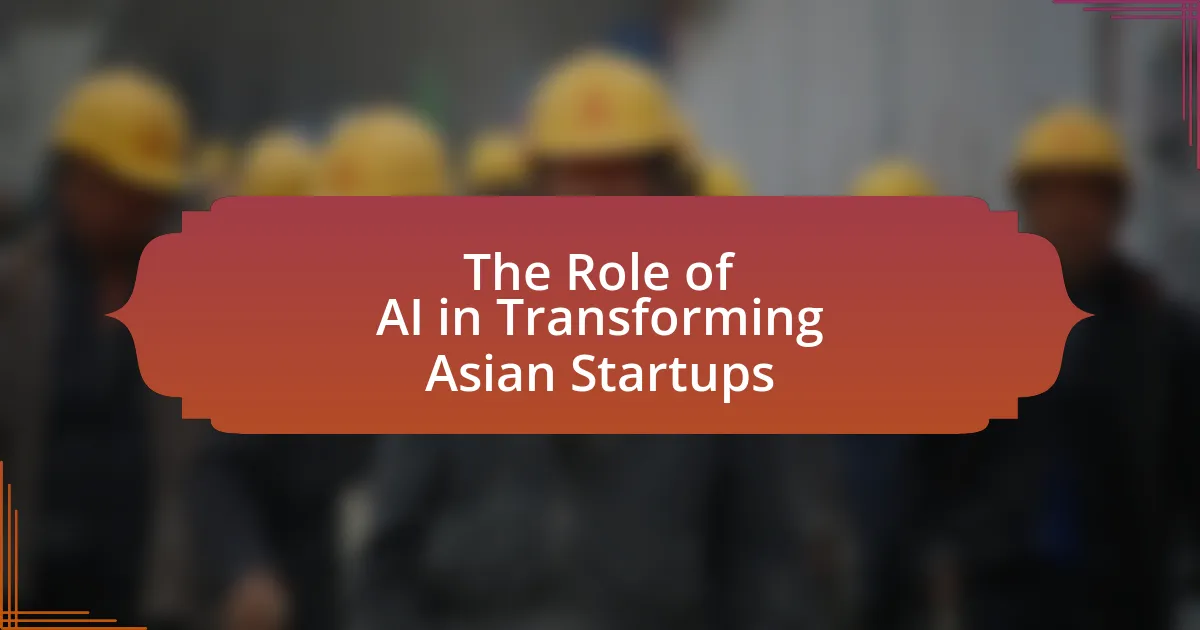The article focuses on strategies for implementing sustainable technology in Asian enterprises, highlighting key approaches such as adopting renewable energy sources, integrating circular economy principles, and leveraging digital technologies for enhanced efficiency. It discusses methods for assessing current technological sustainability, the metrics necessary for evaluation, and the influence of cultural factors on the assessment process. Additionally, the article examines the role of government policy in promoting sustainable technology, the challenges posed by regulatory frameworks, and the importance of collaboration among stakeholders. It also addresses the financial implications of adopting sustainable technology, common barriers to implementation, and best practices for fostering a culture of sustainability within organizations.
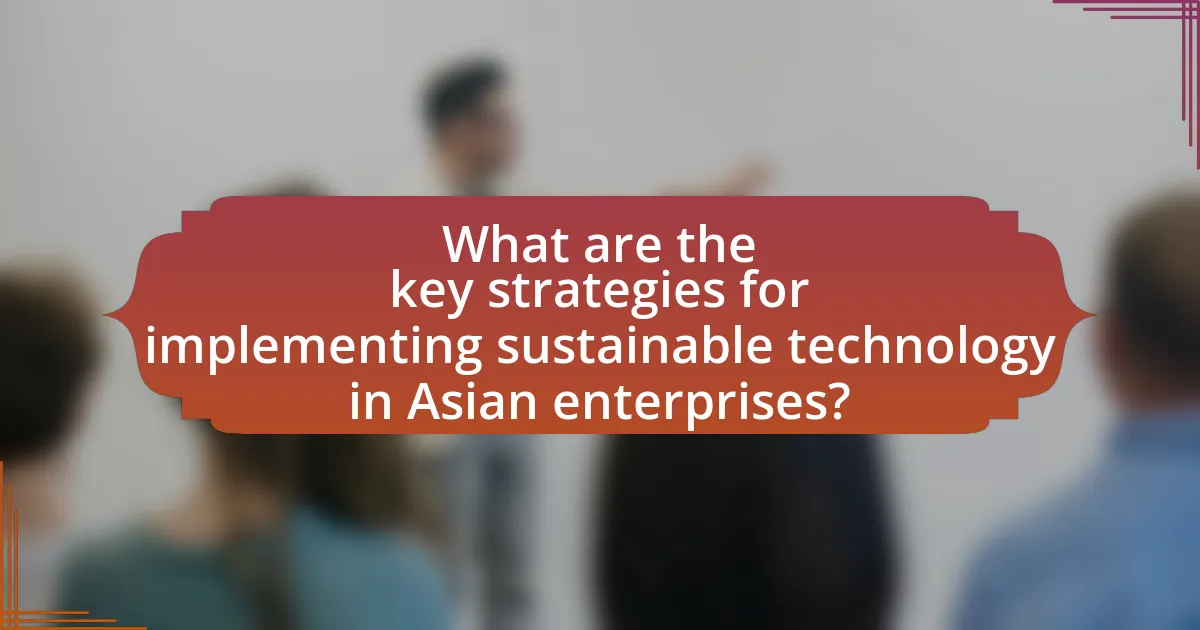
What are the key strategies for implementing sustainable technology in Asian enterprises?
Key strategies for implementing sustainable technology in Asian enterprises include adopting renewable energy sources, integrating circular economy principles, and leveraging digital technologies for efficiency. Asian enterprises can significantly reduce their carbon footprint by transitioning to solar, wind, or biomass energy, which has been shown to lower operational costs and enhance energy security. Additionally, implementing circular economy practices, such as recycling and waste reduction, can lead to resource efficiency and cost savings, as evidenced by companies like Unilever, which reported a 30% reduction in waste through such initiatives. Finally, utilizing digital technologies, such as IoT and AI, can optimize resource management and improve operational efficiency, with studies indicating that digital transformation can increase productivity by up to 20%.
How can Asian enterprises assess their current technological sustainability?
Asian enterprises can assess their current technological sustainability by conducting a comprehensive evaluation of their technology usage against sustainability metrics. This evaluation should include analyzing energy consumption, waste generation, and resource efficiency of their technological processes. For instance, a study by the International Energy Agency indicates that improving energy efficiency in technology can reduce operational costs by up to 30%. Additionally, enterprises can utilize sustainability assessment tools such as the Global Reporting Initiative (GRI) standards, which provide frameworks for measuring and reporting on sustainability performance. By benchmarking against industry standards and utilizing these tools, Asian enterprises can gain insights into their technological sustainability and identify areas for improvement.
What metrics should be used to evaluate sustainability in technology?
To evaluate sustainability in technology, key metrics include carbon footprint, energy consumption, resource efficiency, and lifecycle assessment. Carbon footprint measures the total greenhouse gas emissions associated with a technology, providing insight into its environmental impact. Energy consumption quantifies the amount of energy used during operation, highlighting efficiency and potential for renewable energy integration. Resource efficiency assesses how effectively materials are utilized, aiming to minimize waste and promote recycling. Lifecycle assessment evaluates the environmental impacts of a technology throughout its entire lifecycle, from production to disposal, ensuring a comprehensive understanding of sustainability. These metrics are essential for organizations aiming to implement sustainable technology strategies effectively.
How do cultural factors influence the assessment process?
Cultural factors significantly influence the assessment process by shaping the values, beliefs, and behaviors of individuals involved. For instance, in Asian enterprises, collectivist cultures may prioritize group consensus and harmony over individual opinions, affecting how assessments are conducted and interpreted. Research indicates that cultural dimensions, such as those identified by Hofstede, highlight variations in power distance and uncertainty avoidance, which can lead to different expectations and approaches in assessment practices. These cultural nuances can impact the criteria used for evaluation, the communication style during assessments, and the overall receptiveness to feedback, thereby altering the effectiveness of the assessment process.
What role does government policy play in promoting sustainable technology?
Government policy plays a crucial role in promoting sustainable technology by establishing regulatory frameworks, providing financial incentives, and fostering research and development. These policies create an environment that encourages businesses to adopt sustainable practices, such as renewable energy use and waste reduction. For instance, countries like South Korea have implemented policies that include tax breaks for companies investing in green technologies, which has led to significant advancements in sustainable innovation. Additionally, government funding for research initiatives, such as Japan’s Green Innovation Fund, supports the development of new technologies that address environmental challenges. These concrete actions demonstrate how effective government policy can drive the adoption and advancement of sustainable technology in various sectors.
How can enterprises leverage government incentives for sustainability?
Enterprises can leverage government incentives for sustainability by actively participating in programs that provide financial support, tax breaks, and grants aimed at promoting eco-friendly practices. For instance, many governments offer subsidies for renewable energy projects, which can significantly reduce initial investment costs for businesses transitioning to sustainable technologies. According to a report by the International Renewable Energy Agency, countries that implemented such incentives saw a 30% increase in renewable energy investments within five years. By aligning their sustainability goals with these government initiatives, enterprises can enhance their operational efficiency while benefiting from reduced financial burdens.
What are the challenges posed by regulatory frameworks in different Asian countries?
Regulatory frameworks in different Asian countries pose challenges such as inconsistency, lack of clarity, and varying enforcement levels. For instance, countries like India and China have complex regulations that can differ significantly across regions, leading to confusion for businesses trying to implement sustainable technologies. Additionally, the absence of standardized environmental regulations can hinder the adoption of sustainable practices, as seen in Southeast Asian nations where regulations may not align with international sustainability standards. This inconsistency can result in increased compliance costs and uncertainty for enterprises aiming to innovate sustainably.
How can collaboration enhance the implementation of sustainable technology?
Collaboration enhances the implementation of sustainable technology by fostering knowledge sharing, resource pooling, and innovation among stakeholders. When enterprises, governments, and NGOs work together, they can leverage diverse expertise and experiences, leading to more effective solutions. For instance, a study by the World Economic Forum found that collaborative initiatives in renewable energy projects can reduce costs by up to 30% through shared investments and risk management. This collective approach not only accelerates the adoption of sustainable technologies but also ensures that best practices are disseminated widely, ultimately driving greater environmental impact across industries.
What partnerships are most effective for driving sustainability initiatives?
Collaborations between businesses, governments, and non-governmental organizations (NGOs) are the most effective partnerships for driving sustainability initiatives. These partnerships leverage diverse resources, expertise, and networks to implement sustainable practices. For instance, the collaboration between Unilever and the World Wildlife Fund (WWF) has led to significant advancements in sustainable sourcing and reducing environmental impact, demonstrating the effectiveness of cross-sector partnerships. Additionally, public-private partnerships, such as those seen in renewable energy projects in Asia, have proven successful in mobilizing investment and technology transfer, further validating the importance of collaborative efforts in achieving sustainability goals.
How can knowledge sharing among enterprises improve sustainability outcomes?
Knowledge sharing among enterprises can significantly improve sustainability outcomes by facilitating the exchange of best practices, innovative technologies, and efficient resource management strategies. When companies collaborate and share insights, they can collectively identify sustainable solutions that reduce waste, lower carbon emissions, and enhance overall operational efficiency. For instance, a study by the World Economic Forum highlights that companies engaged in knowledge sharing can achieve up to 20% greater resource efficiency compared to those that operate in silos. This collaborative approach not only accelerates the adoption of sustainable technologies but also fosters a culture of continuous improvement, ultimately leading to enhanced environmental performance across industries.
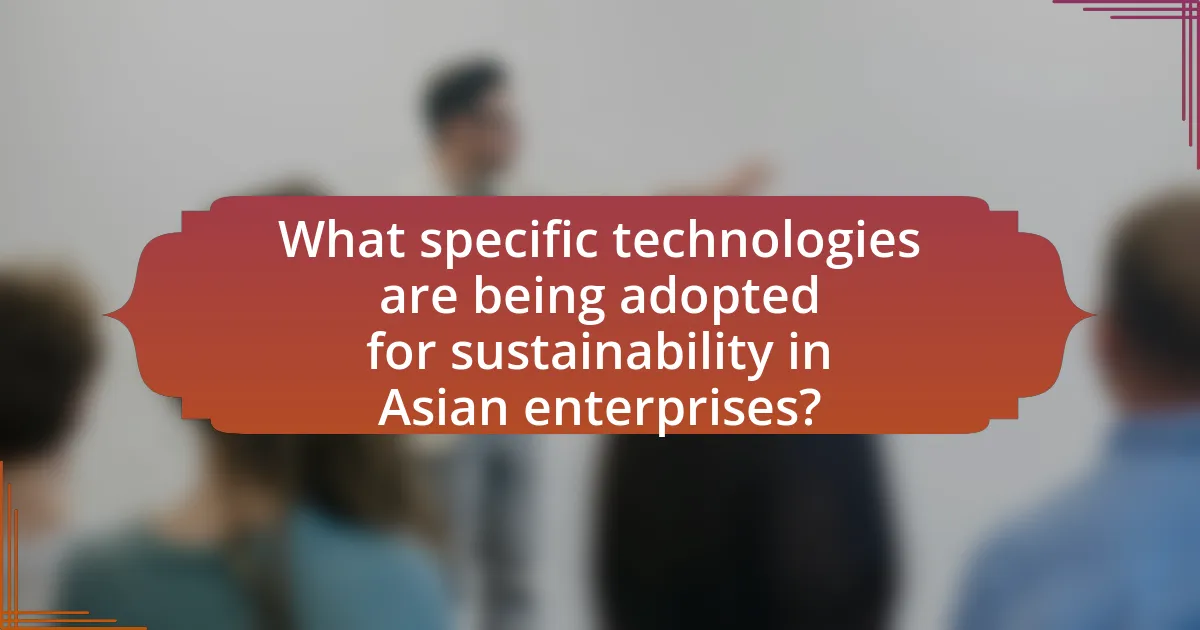
What specific technologies are being adopted for sustainability in Asian enterprises?
Asian enterprises are adopting specific technologies such as renewable energy systems, energy-efficient appliances, and smart grid technologies to enhance sustainability. For instance, solar energy installations have surged in countries like China and India, with China leading the world in solar capacity, reaching over 250 gigawatts by 2020. Additionally, energy-efficient technologies, including LED lighting and high-efficiency HVAC systems, are increasingly utilized to reduce energy consumption. Smart grid technologies are also being implemented to optimize energy distribution and consumption, improving overall efficiency and reducing carbon footprints. These technologies collectively contribute to the sustainability goals of Asian enterprises by lowering greenhouse gas emissions and promoting resource efficiency.
What are the most popular sustainable technologies currently in use?
The most popular sustainable technologies currently in use include solar energy systems, wind turbines, and energy-efficient appliances. Solar energy systems harness sunlight to generate electricity, with global solar capacity reaching over 800 gigawatts in 2020, according to the International Renewable Energy Agency. Wind turbines convert wind energy into electricity, contributing significantly to renewable energy sources, with installed capacity exceeding 700 gigawatts worldwide as of 2020. Energy-efficient appliances, such as LED lighting and Energy Star-rated devices, reduce energy consumption and greenhouse gas emissions, with studies showing that widespread adoption can lead to a 30% reduction in energy use in households.
How do renewable energy sources impact operational efficiency?
Renewable energy sources enhance operational efficiency by reducing energy costs and increasing reliability. For instance, businesses that utilize solar or wind energy can significantly lower their electricity bills, as these sources often have lower operational costs compared to fossil fuels. According to a report by the International Renewable Energy Agency, the levelized cost of electricity from solar photovoltaics has dropped by 89% since 2009, making it a cost-effective option for many enterprises. Additionally, renewable energy systems can provide a stable energy supply, minimizing disruptions and downtime, which further boosts productivity.
What role does smart technology play in enhancing sustainability?
Smart technology significantly enhances sustainability by optimizing resource use and reducing waste. For instance, smart grids enable efficient energy distribution, minimizing energy loss and integrating renewable sources, which can lead to a reduction in carbon emissions by up to 30% in urban areas. Additionally, smart sensors in agriculture monitor soil conditions and water usage, allowing for precision farming that can increase crop yields while conserving water resources. These technologies collectively contribute to sustainable practices by promoting efficiency and minimizing environmental impact.
How can enterprises integrate sustainable technology into their existing systems?
Enterprises can integrate sustainable technology into their existing systems by conducting a comprehensive assessment of current operations and identifying areas for improvement. This involves evaluating energy consumption, waste management, and resource utilization to pinpoint inefficiencies. For instance, a study by the International Energy Agency found that implementing energy-efficient technologies can reduce operational costs by up to 30%.
Following the assessment, enterprises should prioritize the adoption of renewable energy sources, such as solar or wind power, which can be integrated into existing infrastructure. Additionally, utilizing smart technologies, like IoT devices, can optimize resource management and reduce waste. According to a report from McKinsey, companies that adopt smart technologies can achieve a 20-30% reduction in resource consumption.
Furthermore, training employees on sustainable practices and fostering a culture of sustainability within the organization is crucial for successful integration. Research from Harvard Business Review indicates that organizations with strong sustainability cultures see a 50% increase in employee engagement.
By systematically assessing current systems, adopting renewable energy, leveraging smart technologies, and promoting a sustainability-focused culture, enterprises can effectively integrate sustainable technology into their operations.
What steps are necessary for a successful technology integration?
Successful technology integration requires a structured approach that includes several key steps: assessing organizational needs, selecting appropriate technology, planning implementation, training users, and evaluating outcomes.
First, assessing organizational needs involves identifying specific challenges and goals that technology can address, ensuring alignment with business objectives. Next, selecting appropriate technology entails researching and choosing solutions that fit these identified needs, considering factors such as scalability and compatibility with existing systems.
Planning implementation is crucial; this step includes developing a timeline, allocating resources, and defining roles and responsibilities to ensure a smooth transition. Training users is essential to maximize the benefits of the new technology, as it equips employees with the necessary skills and knowledge to utilize the tools effectively. Finally, evaluating outcomes involves measuring the impact of the technology integration against predefined success metrics, allowing for adjustments and improvements as needed.
These steps are supported by research indicating that structured approaches to technology integration lead to higher success rates, as evidenced by a study from the Journal of Information Technology, which found that organizations following a systematic integration process reported a 30% increase in operational efficiency.
How can enterprises ensure minimal disruption during the transition?
Enterprises can ensure minimal disruption during the transition by implementing a comprehensive change management strategy. This strategy should include thorough planning, stakeholder engagement, and effective communication to prepare all employees for the changes ahead. Research indicates that organizations with structured change management processes experience 70% higher success rates in transitions (Prosci, 2021). Additionally, providing training and support resources can help employees adapt to new technologies, further reducing resistance and operational interruptions.
What are the financial implications of adopting sustainable technology?
Adopting sustainable technology can lead to significant financial implications, including reduced operational costs and increased revenue opportunities. For instance, companies that implement energy-efficient systems often experience lower utility bills, which can result in savings of up to 30% annually. Additionally, sustainable practices can enhance brand reputation, attracting environmentally conscious consumers and potentially increasing market share. A study by the Harvard Business Review found that firms with strong sustainability initiatives outperform their peers in stock market performance, indicating a positive correlation between sustainability and financial success. Furthermore, government incentives and subsidies for green technology can offset initial investment costs, making the transition more financially viable.
How can enterprises calculate the return on investment for sustainable initiatives?
Enterprises can calculate the return on investment (ROI) for sustainable initiatives by assessing both the financial and non-financial benefits derived from these initiatives. This involves quantifying cost savings from energy efficiency, waste reduction, and resource conservation, alongside potential revenue increases from enhanced brand reputation and customer loyalty.
For instance, a study by the Carbon Trust found that companies implementing energy-efficient technologies can save up to 20% on energy costs, directly impacting their bottom line. Additionally, enterprises can use the formula ROI = (Net Profit from Sustainable Initiative / Cost of Sustainable Initiative) x 100 to derive a percentage that reflects the financial return. By integrating these calculations with metrics such as carbon footprint reduction and compliance with regulatory standards, enterprises can present a comprehensive view of the ROI for their sustainable initiatives.
What funding options are available for enterprises pursuing sustainability?
Enterprises pursuing sustainability can access various funding options, including government grants, private investments, and green bonds. Government grants often support projects that align with environmental goals, such as renewable energy initiatives or waste reduction programs, providing financial assistance without the need for repayment. Private investments, particularly from venture capitalists focused on sustainable technologies, can offer significant capital in exchange for equity. Additionally, green bonds are debt instruments specifically earmarked for financing environmentally friendly projects, allowing enterprises to raise funds while promoting sustainability. According to the Climate Bonds Initiative, the green bond market reached over $1 trillion in issuance by 2021, indicating strong investor interest in funding sustainable projects.
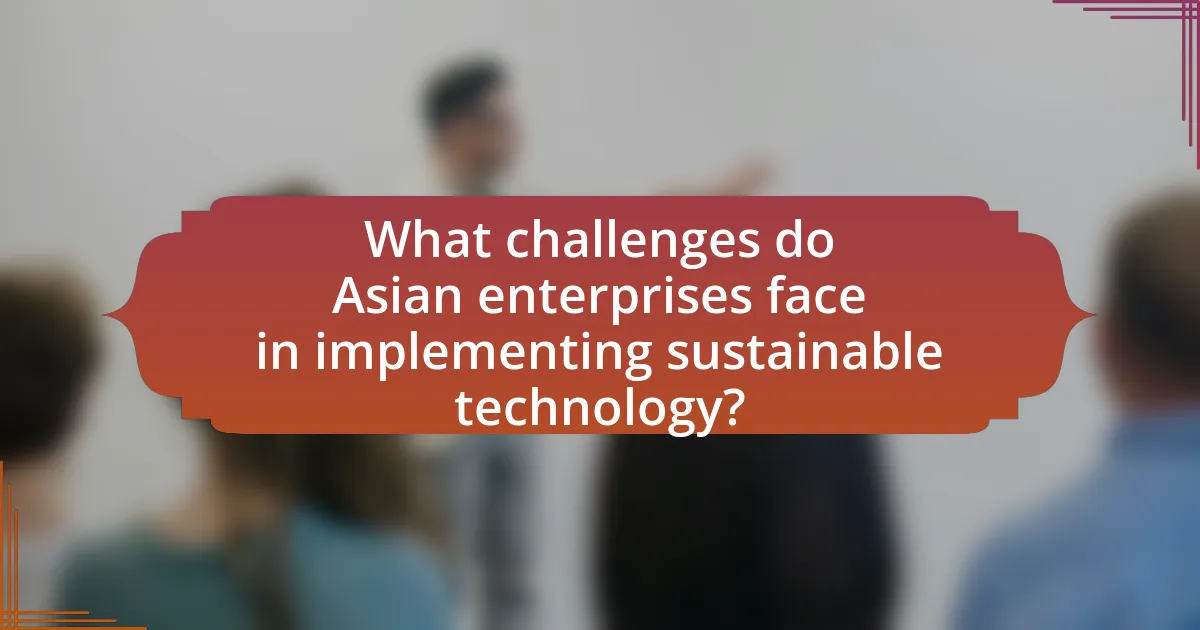
What challenges do Asian enterprises face in implementing sustainable technology?
Asian enterprises face significant challenges in implementing sustainable technology, primarily due to high initial costs, lack of skilled workforce, and regulatory complexities. High initial costs deter many businesses from adopting sustainable technologies, as they often require substantial investment in new infrastructure and processes. Additionally, the lack of a skilled workforce hampers the effective implementation and maintenance of these technologies, as many employees may not have the necessary training or expertise. Regulatory complexities further complicate the situation, as varying environmental regulations across different countries in Asia can create confusion and hinder the adoption of standardized sustainable practices. These factors collectively impede the progress of sustainable technology implementation in the region.
What are the common barriers to adopting sustainable technology?
Common barriers to adopting sustainable technology include high initial costs, lack of awareness, insufficient infrastructure, and regulatory challenges. High initial costs deter many enterprises from investing in sustainable technologies, as they often require significant upfront capital. Lack of awareness among stakeholders about the benefits and availability of sustainable options further hampers adoption. Insufficient infrastructure, particularly in developing regions, limits the implementation of advanced technologies. Additionally, regulatory challenges, such as unclear policies or lack of incentives, create uncertainty that discourages businesses from transitioning to sustainable practices. These barriers collectively hinder the widespread adoption of sustainable technology in Asian enterprises.
How do financial constraints affect technology adoption?
Financial constraints significantly hinder technology adoption by limiting the resources available for investment in new technologies. Enterprises facing budget restrictions often prioritize essential operational costs over technological advancements, resulting in delayed or incomplete implementation of innovative solutions. A study by the Asian Development Bank found that small and medium-sized enterprises (SMEs) in Asia, which often operate under tighter financial conditions, are less likely to adopt advanced technologies compared to larger firms, with only 30% of SMEs investing in digital transformation initiatives. This disparity illustrates how financial limitations can create barriers to accessing and integrating sustainable technologies, ultimately affecting competitiveness and growth in the market.
What role does employee resistance play in the implementation process?
Employee resistance significantly impacts the implementation process by hindering the adoption of new technologies and strategies. When employees resist change, it can lead to delays, decreased morale, and ultimately, failure of the implementation. Research indicates that resistance often stems from fear of the unknown, lack of involvement in decision-making, or perceived threats to job security. For instance, a study published in the Journal of Change Management found that organizations with high levels of employee engagement during the implementation phase experienced a 30% higher success rate in adopting new technologies compared to those with low engagement. This highlights the necessity of addressing employee concerns and fostering a supportive environment to mitigate resistance and enhance the effectiveness of the implementation process.
How can enterprises overcome these challenges?
Enterprises can overcome challenges in implementing sustainable technology by adopting a comprehensive strategy that includes stakeholder engagement, investment in training, and leveraging partnerships. Engaging stakeholders ensures that all parties are aligned with sustainability goals, which enhances collaboration and support. Investment in training equips employees with the necessary skills to utilize new technologies effectively, thereby increasing operational efficiency. Additionally, forming partnerships with technology providers and other organizations can facilitate access to resources and expertise, enabling enterprises to implement sustainable solutions more effectively. For instance, a study by the Asian Development Bank highlights that collaborative efforts among businesses can lead to shared knowledge and reduced costs in adopting green technologies.
What strategies can be employed to foster a culture of sustainability?
To foster a culture of sustainability, organizations can implement strategies such as integrating sustainability into core business values, promoting employee engagement through training programs, and establishing measurable sustainability goals. Integrating sustainability into core values ensures that all organizational decisions reflect environmental considerations, which can lead to long-term commitment. Employee engagement through training programs raises awareness and equips staff with the knowledge to make sustainable choices, evidenced by a study from the Harvard Business Review showing that companies with engaged employees see a 21% increase in profitability. Establishing measurable sustainability goals allows organizations to track progress and hold themselves accountable, as demonstrated by the Global Reporting Initiative, which provides frameworks for sustainability reporting that enhance transparency and stakeholder trust.
How can training and development support technology adoption?
Training and development can significantly support technology adoption by equipping employees with the necessary skills and knowledge to effectively utilize new technologies. When organizations invest in comprehensive training programs, they enhance employee confidence and competence, which directly correlates with higher rates of technology acceptance. For instance, a study by the Association for Talent Development found that companies with strong training programs are 218% more likely to report high revenue per employee, indicating that well-trained staff can leverage technology more effectively to drive business outcomes. Additionally, ongoing development initiatives can address resistance to change by fostering a culture of continuous learning and adaptability, which is crucial for successful technology integration in enterprises.
What best practices should Asian enterprises follow for successful implementation?
Asian enterprises should prioritize stakeholder engagement, clear communication, and continuous training for successful implementation of sustainable technology. Engaging stakeholders ensures that all relevant parties are involved in the decision-making process, which enhances buy-in and reduces resistance to change. Clear communication of goals and benefits helps align the organization’s vision with sustainable practices, fostering a culture of sustainability. Continuous training equips employees with the necessary skills and knowledge to effectively utilize new technologies, thereby increasing operational efficiency. Research indicates that organizations with strong stakeholder engagement and effective communication strategies are 70% more likely to achieve their sustainability goals, as highlighted in the “Global Sustainability Report 2022” by the World Economic Forum.
How can enterprises measure the success of their sustainability initiatives?
Enterprises can measure the success of their sustainability initiatives through key performance indicators (KPIs) that assess environmental impact, social responsibility, and economic viability. For instance, tracking metrics such as carbon footprint reduction, waste diversion rates, and energy consumption can provide quantifiable data on environmental improvements. A study by the Global Reporting Initiative indicates that organizations using sustainability reporting frameworks see a 30% increase in stakeholder trust, demonstrating the effectiveness of transparent measurement practices. Additionally, employee engagement surveys can gauge social impact, while financial performance metrics can illustrate the economic benefits of sustainable practices, reinforcing the overall success of these initiatives.
What ongoing support is necessary to maintain sustainable technology practices?
Ongoing support necessary to maintain sustainable technology practices includes continuous training, regular audits, and stakeholder engagement. Continuous training ensures that employees are updated on the latest sustainable practices and technologies, which is crucial for effective implementation. Regular audits help organizations assess their sustainability performance and identify areas for improvement, thereby ensuring compliance with environmental standards. Stakeholder engagement fosters collaboration and accountability, as it involves all parties in the sustainability journey, enhancing commitment and resource sharing. These elements collectively contribute to the long-term success of sustainable technology initiatives in enterprises.



